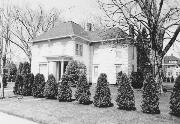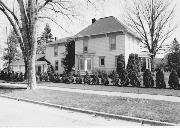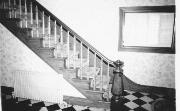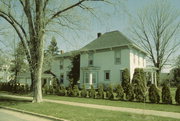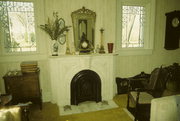| Additional Information: | A 'site file' exists for this property. It contains additional information such as correspondence, newspaper clippings, or historical information. It is a public record and may be viewed in person at the Wisconsin Historical Society, State Historic Preservation Office.
Glover was the owner of the Willow River Lumber Co. Aluminum siding is the exterior fabric on this two story residence. The plan is irregular but follows a rectangular pattern. The south or front part of the roof is a hip roof, the rear has a gabel roof. Sawn wood brackets and a plain frieze are under the eaves. Asphalt shingles are the surface material on the roof. The foundation/basement is constructed of brick. The south facade has three symmetrically placed windows on the second story. These have wood frams with an entablature head. Below this is a large Queen Anne window with leaded glass at the top. It also has an entablature head frame. To the east of this is the entry. This is a stoop proch with flat roof. This roof cornice is boxed and has brackets below. There are two fluted columns with capitals and two pilasters of the same style. Double doors are under the porch.
On the west side (south corner) are two first story square leaded glass windwos with wood entablature head frames. To the north of this is a one story bay window with a low pitched roof, box cornice and quadruple brackets. On the second story are two windows. The house plan narrows at this point (a rear addition) and another leaded glass window is here. North of this is the one story garage. The east side of the house has an entry at the north end. South of this is a one-bay ell. The south side of this ell has two windows on both stories. The south part of the east side has a rectangular first story window.
The corner lot is fenced with evergreens and a few evergreens are placed enar the house. Trees are to the east and west of the house. The effect is one that shows the house off quite well. This residence is larger than most on the street. Physically and visually it is more appropriate to link this home with those on West First Street. The residents of this home throughout the years are also closely lined to those on West First Street. As an individual residence the house has been too altered to have architectural significance. However, its character is cush that it still fits nicely into the streetscape.
Background:
Frank W. Bartlett was the first resident of this house. His parents had come to New Richmond from Maine c. 1858. His father (Josel or Josiah) was the city's first post master and a teacher. J. Bartletts' sister Charlotte Simonton was the mother of another early settler, M.L. Simonton (See SC20-20, 313 West Second. The English branch of the family was still on the family estate at this time and most of the American branch was back east.
F.W. Bartlett had a furniture store c.1874-80 (and possibly longer). He also taught Sunday school. In 1878 when the Bank of New Richmond opened he was the vice-president and on the board of directors. It was located above his store. By 1893 Bartlett was bank president. His wife was Mary Stuart of Pennsylvania. In 1879 they had a son./ At this time Bartlett was the village president (this would make him the second or third president). They had two sons who attended Princeton. The older became a Congregational minister there.
According to the property abstract Bartlett acquired the land his house was built on in 1873. An 1875 newspaper item noted that Bartlett was filling up his yeard with shade trees. An 1899 he was living in the "west end", which is the area of this piece of property. He was taking down fences and planting maples in 1891.
An 1887 news arciles noted that Bartlett was adding onto the east side of his house.
The June 12, 1899 tornado damaged the house. A large bay window that was extension of the back parlor (SW part of house) and a cupola were blown away. The northwest wing was blown off its foundation and chminey lost. Moquette carpets were used to cover the hole in the roof. The house was described as being large and brown colored. Bartlett also lost three other residences in this neighborhood. His financial losses were estimated at about $10,000.00.
In the fall of 1902, Mr. and Mrs. John E. Glover purchased Bartlett's house. He would move to New Richmond from Hudson and make this his permanent home. Winter would be spent at his daughter Minnie Baker's home (see SC 20-2, 222 West First Street). Actual possession of the house would be in the spring.
John Emerson Glover was born in Vermont in 1841. His family moved to St. Croix County in 1856. He was educated at River Falls Academy and in Ann Arbor Michigan. After serving in the Civil War he took up practicing law in Hudson. In 1865 Glover married Ellen Ensign of New York. They had four children. In 1875 he was the County District Attorney. In 1881, Glover organized Willow River Lumber Company in New Richmond. It began as a one saw operation and by 1903 was the largest single employer in the city. In 1910 it employed 185 people out of a population of 2,000. The company burned to the ground in 1913 and was not rebuilt.
Pre-1900 newspaper articles note that Glover was buying main street properties.m He also bought into New richmond Roller Mills, the city's second largest employer. Glover established and was president of the Manufacturers Bank in 1887. In 1895, he was a partner with H.C. Allen in a drug store and part owner of the flour mills. By 1901, he was not a partner in either establishment. Glover also onwed timber in northern Wiscnsin, his own rail track and lumber interests in Amery, Clear Lake, Grandview and Hayward. He had a home in Hudsn, the 1,500 acre Willowville Farm near Clear Lake and 560 acres outside of New Richmond known as Gloverdale. Glover Park, the first part in New Richmond, was donated by him in 1913. He died in 1917.
The house stayed in the family (widow and son Leslie) until Warren P. and Dorothy Knowles bought it in 1956. Knowles was from River Falls. He had practiced law in New Richmond since 1933. KNowles was a state senator, businessman, lieutenant governor and from 1964-1971 governor.
A stereoscope photo identified as "Frank Bartlett House, Richmond, Wisconsin" shows a residence with the same basic shape as today but many changes. There was a one story full front porch with columns with capitals. An entry can be seen on the east and two shuttered 2/2 window. The second story view is blocked by tree branches. The hip roof has a low pitch and cresting. The roof has a box cornice with paired brackets and a plain frieze below it. There are wide pilaster endboards. The east side ell is surrounded by a ballustrade or railing with finials at the corners. The west wall in front of the ell has only one oval window in the center (interior stairs are here leading to the second story). Below this on the ground is a low railing that extends to the ell. The ell has one window on each story. They are 2/2 with shutters and a triangular shaped head/ North of the ell is a one story section on which can be seen a gable wall dormer and two windows.
The cupola, part of the roof and rear were lost in the tornado. When Glover moved in the paper noted that the "Hon. J.E. Glover has a crew of men at work on the Bartlett house and is giving it a thorough overhauling,". A 1912 Sanborn Map shows that the ell has been extended. There is another ell at the NE corner and this part of the house is probably new. In 1927 there is an addition between the ells.
A c.1940 photo shows a steeper pitched roof with a front gable dormer. A winder full porch in front is open on the first story and has a sleeping porch above it. Porch columns are round with capitals. There is a low railing on the east side of the porch that extends back to the ell. This ell can be seen to have two windows on each story. The east side wall now has a second story window and a rectangular first story window. The round window is still here (today this has been covered over).
Significance:
John Glover was the individual most important to the economy of New Richmond c. 1880-1917. As the largest employer (bank, flour and lumber mills) he had an immense amount of power and control in the city. Much of the prosperity and progress of New Richmond was because of his businesses. When he moved into the city in 1903 he modernized the 1870's Bartlett house. The present house is more accurately dated from this post-Victorian era than the time 25-30 years prior. This residence has local hsitorical significance because of its association with Glover and his pivotal role in the turn of the century business and economic climate of the city. |
|---|

